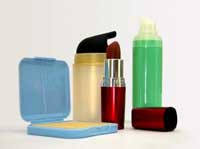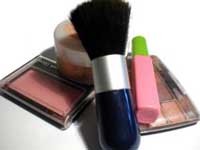


| HOME | MENU | DOCS | SEARCH |
Page 1 of 4
In contents of the article Cosmetics
— It is accepted to understand substances as this name "cosmetics" part medical, part of purely toilet character, used as external means for the purpose of care of various parts of a body. This leaving is caused, on the one hand, desire inherent in the person more beautiful to seem, with another — it is sometimes necessary owing to the known requirements imparted by a habit and education, sometimes useful and in the hygienic relation, sometimes purely conditional.
In Europe consumption of cosmetics was especially great in the XVII century in France where it passed from Rome and from where extended little by little everywhere. In 1642 Fitelye wrote that the toilet of the elegant lady requires the whole bench of cosmetics — various grindings, whitewash, blush, corrosive sublimate, alum, a cow dung, vinegar, spirits, almond milk, etc. The fashion to rumyanitsya, taken root at first in the highest sections of society, extended then both on other classes and in the XVIII century powder and blush were in Europe inevitable accessory of a toilet of all women without distinction of their social standing.
The fabrication of cosmetics and spirits which arose in wide sizes in France was allocated there in the special quite large industry which from year to year is more and more developing despite the general reduction of use of cosmetics seeming now; demand for cosmetic and perfumery products increases every year, and in one Paris the annual turnover on trade in cosmetics and perfumery makes nowadays over 50 million francs (1905). The laboratory technical aspect of production and composition of some, most widespread cosmetics, and being with them in close connection of different perfumery materials, spirits, etc. is in brief specified in the present article.
As the major material on value for preparation of cosmetic and perfumery products (ointments, balms, spirits and so forth) various fragrant substances serve, we also will begin with the description of the general properties and which ways of preparation. The majority of the fragrant substances used in perfumery business — a natural origin is also drawn in a ready view ready or nearly from plants; it is a little fragrant substances of an animal origin having application in perfumery — musk, a beaver stream, cibetin and ambergris which fragrant beginning still it wasn't succeeded not only to investigate chemically but also to receive in a little pure look.
Aroma of the majority of plants depends on the special volatiles called by essential oils (see); to number of fragrant substances of a phytogenesis, except essential oils, pitches and balms belong related with them by origin. These substances meet in various bodies of plants — in flowers, leaves, fruits, wood, bark, roots, and from there are drawn by means of special techniques. It is impossible to judge number of the content of essential oil in these parts on a smell by no means; some strongly odorous plants contain very little essential oil that it didn't manage to be allocated still in a free state; others, on the contrary, with a smell weak rather, bring large amounts of essential oil, as e.g. the plants belonging to Labiata, Umbellifera and Crucifera families.
The greatest intensity of aroma flowers of tropical countries — the East Indies, Ceylon, Mexico, Peru, etc. possess; the most delicate odorous substances, the most valued in perfumery, are got from plants of a temperate climate. — Graz, Cannes and Nice — the main points of the present perfumery industry. Nice is well-known for the violets, Cannes — roses, acacias, a jasmine and an orange blossom; Is famous for It for a thyme, rosemary, a lavender; Italy delivers an iris and a bergamot.
To number of perfumery materials, except mentioned (a natural origin — animal and vegetable), it is necessary to carry also very small number of the artificially prepared — benzopyrone, гелиотропин, vanillin and nitrobenzene. As it was already mentioned, the perfumery industry reached the greatest development in the south of France where production of essential oils, spirits and so forth perfumery products from own and imported materials has the factory sizes and a situation.
Production of essential oils is made on the following five methods: pressing, distillation, extraction, maceration and absorption (enfleurage) applied in compliance with properties of essential oil and its contents in a plant. Pressing is applied only at extraction of essential oils from fresh-gathered plants rich with the contents, as, e.g., from fresh lemon and orange crusts, etc. The essential oils received thus separate from watery and other impurity by means of upholding and a filtration.
Distillation — most often the used method, but it is suitable too only at plants with the considerable content of essential oils and, besides, only when fragrant properties of essential oil from distillation don't worsen that happens to some gentle grades; happen also such which don't take out high heating at all and decay at an otgonka. Essential oils have boiling temperature above 100 °C, but they are easily driven away in a stream of water vapor therefore their otgonka is made in the boiling water in the ordinary distillation devices heated by naked fire or steam, or a stream of direct steam. The mix of water and radio vapor which passed through the refrigerator is divided by means of the florentinskikh of large bottles or settling funnels.
Extraction of essential oils extraction consists in processing of plants various solvents — sulfuric or oil air, sulphurous carbon, etc., and in the subsequent then an otgonka of solvent from essential oil. Well cleared oil air which isn't leaving behind any smell and quite low boiling (about 50 °C) is most suitable for this purpose. A lack of this very easy and cheap way that together with essential oils pass into solution also fat, resinous, etc. the substances which are extremely difficult separated from essential oil (by means of an otgonka of the last) why this way is applied now seldom and only when processing the plants rich with the content of essential oil.
Maceration is applied when processing flowers with the insignificant content of essential oil or when it doesn't take out considerable heating without change in properties. Process of maceration consists in insisting of the processed fragrant plants in the kindled lard or warm oil, olive or mineral (perfumery), at speed. about 65 °C within 12 — 48 hours then the flowers which transferred the aroma to fat are taken out from it and are replaced fresh that repeats several times. The quantity of such nastaivaniye depends on breed of a plant and desirable extent of saturation of fat fragrant substance. From strongly scented fat received thus called in France by flower lipstick (pommade) or oils (huile antique), prepare spirits. Further >>
•Page. 1• — •Page. 2• — •Page. 3• — •Page. 4•
When writing this text material was used from
Encyclopedic dictionary of Brockhaus F.A. and Efron I.A. (1890 — 1907).
Photo from the site sxc.hu

| 
| 
|
We recommend that you look at the popular sections of the site myvaleology.com: MENU with a description of the sections | |||
| SOCIAL | DONATION | MY DIET | MY SPORT |
|
|
Release all4e8 |
||
Copyright © VZOJ 2023. All rights reserved. When reprinting or quoting myvaleology.com materials please put a link to the site myvaleology.com :
<a href="https://myvaleology.com">Healthy lifestyle</a>